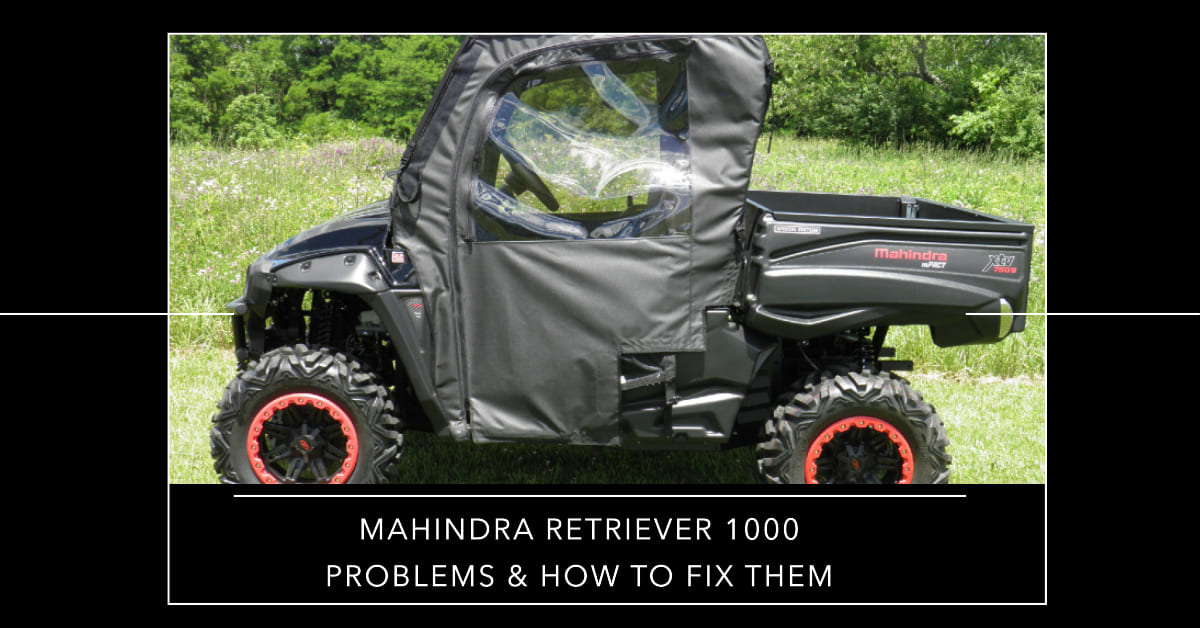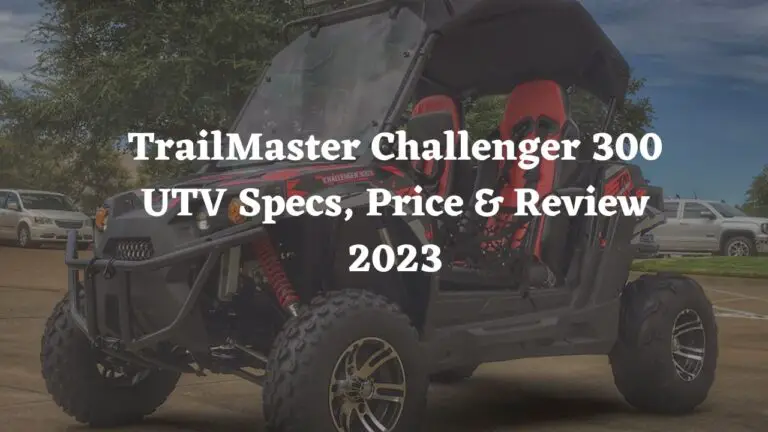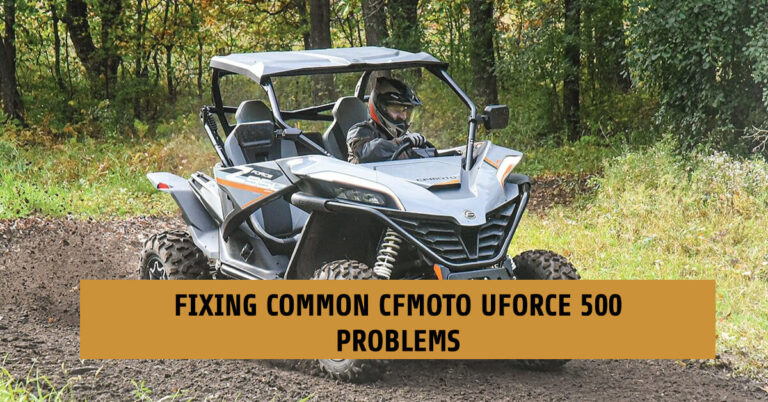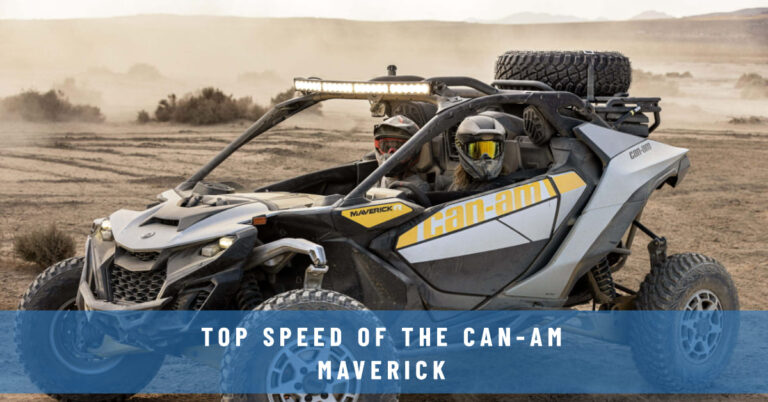Mahindra Retriever 1000 Problems & How to Fix Them

The Mahindra Retriever 1000 has become one of the most popular tractors for small farms, orchards, vineyards, and large residential properties. With its compact size, maneuverability, anddurability, it’s easy to see why the Retriever 1000 is a favorite for property owners who need an affordable, capable tractor.
But like any machine, the Retriever 1000 can develop issues over time. What are the most common Mahindra Retriever 1000 problems owners face? And how can you diagnose and repair these problems yourself?
The good news is that many Retriever 1000 problems are easy to identify and fix yourself if you know what to look for. In this detailed post, we’ll overview the top issues that crop up in the Retriever 1000 and provide tips to troubleshoot and resolve them on your own. With a combination of preventative maintenance and prompt repairs, you can keep your Retriever 1000 running strong for years.
Table of Contents
An Overview of Common Mahindra Retriever Problems
The Mahindra Retriever 1000 is powered by a 3-cylinder, direct injection diesel engine that outputs 37HP. This simple yet durable engine is one reason for the Retriever’s popularity. But it is still susceptible to typical problems found in any diesel tractor:
- Engine issues: Overheating, lack of power, excessive oil consumption, and strange noises point to underlying engine problems. These can range from clogged air filters to low compression.
- Transmission problems: The constant shifting and torque take a toll on the transmission. Faulty gears, leaks, and odd noises are signs of trouble.
- Hydraulic problems: Leaks, loss of power, and failure to raise/lower implements means issues with the hydraulics.
- Electrical issues: Faulty wiring and connections cause problems starting, lights malfunctioning, and gauge failures.
In the sections below, we’ll explore the specific causes behind these common Retriever 1000 problems. We’ll provide tips to diagnose each problem yourself as well as steps to repair issues on your own or determine if it requires a professional mechanic’s expertise. But first, let’s overview some key maintenance practices that can prevent or minimize many Retriever problems.
Preventative Maintenance Tips for the Retriever 1000
The best way to avoid major, costly repairs down the road is to follow diligent maintenance practices for your Retriever. Here are some key preventative maintenance tips:
- Follow the maintenance schedule: Refer to your owner’s manual for the recommended service schedule. This includes oil changes, filter changes, belt inspection, lubrication, and more. Don’t skip or delay intervals.
- Inspect fluids, filters, belts: Check engine oil, transmission fluid, coolant, and hydraulic fluid levels frequently. Replace filters as needed. Examine belts for cracking or glazing.
- Clean debris: Use compressed air or low-pressure water to remove debris like grass clippings from the engine compartment and radiator fins regularly. Debris causes overheating.
- Watch gauges and lights: Monitor gauge readings for anything unusual. Note warning lights for issues. Address any problems immediately.
- Listen for noises: Strange engine noises, knocking or grinding from the transmission, or other unusual sounds indicate problems. Diagnose noises early.
- Address leaks quickly: Leaks allow vital fluids to escape. Seal any external or internal leaks right away before major damage occurs.
- Use clean fuel: Fill up from reliable diesel pumps and use additive to prevent algae or contaminant build-up in the fuel tank which clogs injectors.
- Protect from elements: Keep your Retriever housed or covered when not in use to protect it from sun, moisture, dust, and pests.
With diligent preventative maintenance and prompt repairs, your Mahindra Retriever 1000 will provide reliable service for the long run. But even well-maintained equipment can experience issues. Let’s look in-depth at the most common problems Retriever owners face.
Common Mahindra Retriever 1000 Engine Problems
The high-duty cycle placed on a compact utility tractor makes the diesel engine susceptible to a number of potential issues. Here are the most common Mahindra Retriever 1000 engine problems and how to diagnose and repair them:
Overheating Issues
Excessive engine operating temperature is one of the most serious problems on the Retriever 1000. Left unchecked, overheating can lead to blown head gaskets, cracked heads or engine blocks, and even total seizure. Here are the top causes of overheating:
- Clogged radiator: Debris like grass clippings can block airflow through the radiator fins. Use compressed air or water to remove built-up debris. Avoid blowing debris towards the radiator when mowing.
- Faulty water pump: The water pump circulates coolant through the block and radiator. A bad bearing or impeller will reduce flow, leading to overheating. Check for leaks or noises from the pump. Replace if faulty.
- Stuck thermostat: The thermostat regulates coolant flow to maintain the proper operating temperature. A stuck closed thermostat prevents circulation, causing overheat. Replace the thermostat if faulty.
- Low coolant: Lack of sufficient coolant due to leaks or neglecting to maintain proper level leads to hot spots in the block. Address external leaks, pressure test system, refill coolant.
- Damaged radiator cap: The cap maintains the pressurized cooling system. Weak spring pressure in cap results in coolant boiling over. Replace cap if worn.
Overheating can occur gradually or suddenly, depending on the cause. Watch temperature gauge closely for any higher than normal readings and shut off engine if rising rapidly. Troubleshoot causes before running again to avoid catastrophic failure.
Low Power Issues
Lack of power under load is another common complaint with the Retriever 1000. The tractor feels sluggish and struggles maintain speed under heavy load conditions. Here are some potential causes:
- Clogged air filter: The air filter that cleans intake air can get overly dirty, restricting airflow to the cylinders. Inspect and replace clogged air filters promptly.
- Faulty fuel injectors: Issues like leaking injector seals, clogged tips, or failure to open efficiently reduces fuel delivery. Test injector function and replace any faulty units.
- Engine compression: Low cylinder compression due to worn piston rings, pistons, valves, etc reduces combustion efficiency. Perform compression check. Rebuild top end if low.
- Contaminated fuel: Water, algae, sediments or varnish in the fuel clogs filters and injectors. Keep tank full. Use biocides. Install primary fuel filter.
- Turbocharger failure: Vanes sticking or damage impeller wheel causes loss of boost pressure. Check for turbo noise or play. Replace if faulty.
Monitor changes in engine sound, lag in throttle response, lack of boost pressure, or increased smoking which indicate loss of power problems. Treat the root cause, not just symptoms for a lasting repair.
Excessive Oil Consumption
While diesel engines do consume a small amount of oil naturally in combustion, excessive oil use points to leaks or internal issues. Common causes include:
- Worn piston rings: The piston rings seal against the cylinder walls. As they wear, combustion gases blow by, entering the crankcase. Perform leakdown test to confirm. Repair involves overhaul.
- Cracked engine block: Extreme overheating can cause cracks in the cylinder walls or head, allowing oil to leak into combustion chamber or externally. Pressure test cooling system. Inspect for external leaks. Repair or replace block as needed.
- Blown head gasket: Failed head gaskets allow oil and coolant to mix. Check for white exhaust smoke, overheating, oil in coolant. Retorque head bolts first. If issue persists, replace head gasket.
- Leaking seals or gaskets: Oil leaks past worn seals like valve cover, oil pan, front/rear crankshaft seal . Inspect closely for external leaks. Replace worn seals and gaskets.
Watch for rising oil usage on dipstick along with white exhaust smoke which signals leaks. Repair promptly to avoid engine damage. Keep spare quarts of oil on hand for top-ups between changes if consumption is high.
Strange Engine Noises
Unusual sounds from under the hood often indicate problems. Here are some common noises and potential causes:
- Ticking/tapping: Low oil level allows valvetrain components to make contact. Check level. Add oil. If full, leakdown or oil pressure tests needed.
- Knocking: Hard metallic knocks often signal serious issues like rod or main bearing failure, or piston slap. Stop engine ASAP if loud knocking heard. Major repairs ahead.
- Grinding: Damaged or failed starter pinion gear engaging makes grinding when starting. Remove and inspect starter. Replace if damaged.
- Whining: Generator/alternator bearings cause whining noises when failing. Replace alternator. Check belt tension.
- Growling/screeching: Failing idler or accessory pulleys make unusual growls or screeches. Isolate bad bearings by removing belts one by one.
Unfamiliar engine noises must be investigated immediately to prevent complete failures. Locate the source and repair.
Diagnosing and Repairing Retriever 1000 Transmission Problems
The transmission takes constant abuse on a utility tractor like the Retriever 1000. The gearset bearings, shafts, and synchronizers endure heavy loads hour after hour. This inevitably takes a toll, leading to several widespread transmission problems, including:
- Difficulty shifting: Worn shift forks, leaking seals, and contaminated oil makes shifting difficult. Transmission may slip out of gear.
- Leaking fluid: Seals and gaskets wear over time, allowing leaks. Pooling fluid indicates leak source. Replace worn seals and gaskets promptly.
- Noisy operation: Worn bearings, damaged gears, and insufficient lube causes grinding or whining. Noise gets louder in certain gears.
- Gear slipping: Worn clutches fail to fully engage gearsets leading to slippage, especially under heavy loads.
- Complete failure: Broken shafts, damaged gears, or catastrophic bearing failure causes complete transmission failure. Requires overhaul or replacement.
Catching transmission problems early makes repairs easier. Here are some tips for diagnosing issues:
- Note when issues occur: Does grinding only occur with clutch engaged? Problems only in certain gears? Try to isolate when noise, slippage, or leaks arise.
- Check fluid: Low, dirty, or contaminated fluid causes problems. Check level often. Change fluid/filter per maintenance schedule.
- Inspect externally: Examine for any leaks near seals and gaskets. Gear damages causes metal chunks in oil.
- Remove inspection covers: Some transmissions have inspection covers to examine gears. Watch while operating.
- Test in operation: Load test by operating tractor under heavy load like back blading dirt. Does it exhibit slipping? Difficulty shifting? Listen closely for any unusual noises.
- Compare to service manual: Review specifications like gear tooth clearance, gear runout, clutch pack clearance, synchronizer engagement to find out of spec wear.
Many minor transmission issues can be repaired or parts replaced individually like bearings, synchronizers, and gears. But extensive damage will require professional overhaul or replacement. Act quickly when problems arise to avoid ruining the entire gearset.
Troubleshooting Mahindra Retriever Hydraulic System Problems
The hydraulic system powers implements like loaders, attachments, lift arms, and three-point hitch. Failures here prevent implements from functioning properly. Some common issues:
- Loss of lifting power: Leaks, pump wear, faulty valves reduces lift capacity and lowering speed.
- Failure to raise/lower: Severe leaks, pump failure, electrical fault causes implements to stop responding.
- Leaking fluid: Damaged hoses, external leaks around the pump, valves, and cylinders.
- Weak/inconsistent pressure: Worn pump vanes, broken teeth on pump sprocket, and bad control valves affect pressure.
- Loud knocking noise: Cavitation caused by insufficient fluid, overheating, or faulty suction leads to system damage.
Start diagnosis by performing a visual inspection of the hydraulic system:
- Check fluid level: Low fluid reduces pump suction capability. Maintain proper level and change fluid/filters regularly.
- Inspect hoses: Look for cracked, abraded, or leaking hoses. Replace damaged hoses.
- Examine pump: Note any external leaks at pump shaft seal, gasket, or rear cover. Shaft should turn smoothly with no noise or looseness in bearing. Rebuild or replace leaky, worn pump.
- Test valve function: Actuate hydraulic valves while system is under pressure. Listen for odd sounds indicating faulty cartridge or stuck spool.
- Operate implements: Note sluggish operation, intermittent function, or lack of lifting capacity indicating issues.
Pinpoint the source of any leaks or malfunctions. Repair or replace hydraulic components as needed. Debris is a common cause of clogs and failures – replace filters and maintain clean fluid.
Electrical System Issues on the Retriever 1000
Like any equipment, the Retriever’s electrical system can cause its share of headaches when things go awry. Here are the most common electrical issues:
- Failure to start: Faulty battery connections, ground strap, starter solenoid, or ignition switch causes no crank when starting.
- No power: Blown main fuse, faulty alternator, or wiring faults causes complete electrical failure.
- Intermittent operation: Corroded or loose connectors, broken wires, and short circuits causes glitches.
- Accessory failures: Lights, PTO, gauges etc stop working due to fuses, switch, wiring, or component failures.
- Gauge/sensor faults: Inaccurate or erratic gauge operation points to faulty sender, wiring, or ground.
Troubleshoot electrical problems systematically:
- Check battery condition: Use voltmeter to test battery state of charge. Charge or replace battery as needed. Clean terminals.
- Inspect wiring: Look for chafed, cut, loose, or corroded wiring. Repair or replace damaged wires.
- Confirm ground: Verify block has clean ground strap to chassis. Check ground connections are tight.
- Test circuits: Use multimeter or test light to check power at fuse block, switches, and components.
- Bypass components: Swap or bypass suspect switches, sensors, and relays to isolate failure.
- Review wiring diagram: Use diagram in service manual to follow circuits and locate faults .
Electrical issues can be time-consuming to isolate but are usually repairable. Address charging system problems immediately before battery drain strands you.
When to Call a Professional Retriever 1000 Mechanic
While many Retriever 1000 repairs fall within the DIY realm, some jobs require a professional shop with special tools and expertise. Consider leaving major repairs to the professionals:
- Engine/transmission overhaul: Rebuilding engines or gearboxes requires special tools and training to disassemble, inspect, and reassemble properly.
- Major hydraulic repairs: Proper procedures must be followed when disassembling sophisticated hydraulic systems to avoid damage.
- Significant disassembly: Removing large components like engine or transmission needs overhead lifting equipment.
- Specialized testing: Proper diagnosis of some issues requires dynamometer testing, compression/leakdown checks, hydraulic pressure testing, etc.
- Major electrical faults: Diagnosing significant electrical problems often requires wiring diagrams and harness testing tools most owners don’t possess.
There is no shame in seeking professional assistance when faced with major mechanical issues, complex disassembly, or diagnostics beyond your capability. The cost of repairs by qualified mechanics is worthwhile to keep your Retriever 1000 running reliably for years to come.
Keep Your Mahindra Retriever 1000 Running Smoothly
The Mahindra Retriever 1000 continues to be one of the most popular choices for small acreage owners and mini-farmers due to its proven reliability and affordability. But all tractors eventually face issues with components like the engine, transmission, hydraulics, and electrical system. The keys are diligent preventative maintenance, prompt diagnosis of problems, and properly repairing issues before lasting damage occurs.
Knowing the most common Retriever 1000 problems will help you detect issues in the early stages. Following the troubleshooting tips provided allows you to resolve many problems yourself or determine if it requires a professional repair shop. With ongoing maintenance and care, your Mahindra Retriever will provide decades of dependable service on your property.







